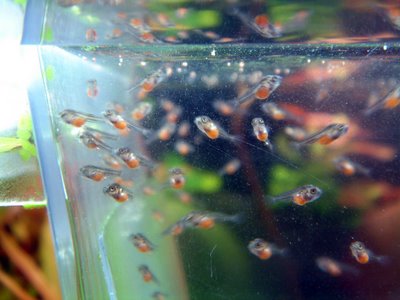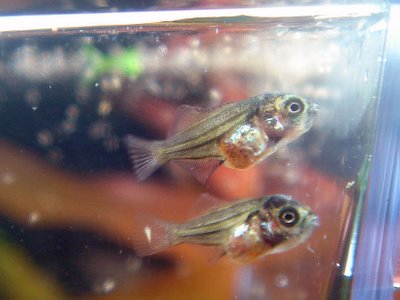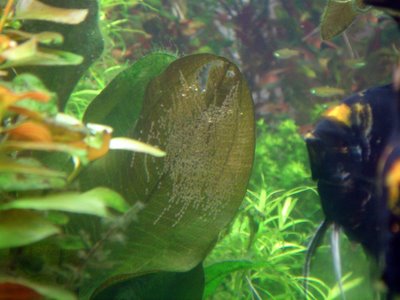Angelfish baby pics
The angelfish pair will select a flat surface, e.g. a sword plant leaf, or the filter intake tube, or the tank wall, and clean it in preparation for the spawning. They will drive away any other fish in the tank from this area. You will see the papilla, or the breeding tubes emerge from both fish in front of their anal fins. The female's papilla will be larger and more blunt. The male's papilla will be smaller and pointier. When satisfied that the flat surface is ready, the female will brush against the flat surface with her papilla, laying her eggs in rows. The male will follow her, fertilizing the eggs. This will usually take a couple hours.
The following schedule of development occurs at 80-84 degrees. At lower temperatures, the rate of development will be slower.
The eggs are transluscent with a yellowish tint. On Day 1, you will see some eggs turn white. These are infertile or dead eggs. Both angelfish will tend to the eggs, keeping them clean of fungus and removing dead eggs if possible.
 Day 2
Day 2On day 2, the eggs will sprout wriggling tails. At this point, my angelfish usually will try to move the wrigglers to another leaf. The wrigglers usually will stick to the flat surface, but many times, they wriggle so energetically that they fall off, and the angelfish will comically try to pick up the eggs and spit them over and over and over again back on to the surface until they finally stay put. I usually siphon off the wrigglers with a turkey baster into a separate container. I like to let the angelfish pair tend to the eggs until this point, since they do a good job of keeping the eggs clean of fungus. Dead eggs quickly encourage the growth of white, fuzzy fungus, which may endanger the other eggs. Once the eggs become wrigglers, though, they are usually safe from a fungus attack.
I usually put the wrigglers into a plastic cup and put the cup into a plastic breeding cage that floats in the community tank. I use a breeding cage because I am too lazy to set up and maintain a separate tank. Using the community tank, I don't have to worry about daily water changes, and my heavily planted tank soaks up the extra generated fish waste. I put the wrigglers into a cup so that when I perform my weekly water change, I can easily lift all the eggs out of the tank.
On Day 4, I usually see eyes develop in the fry. On day 5, the eyes will become more well developed.
 Day 7
Day 7On Day 6, some of the fry may become free swimming. On day 7, all the fry should become free swimming. It is on this day that you should start feeding them newly hatched brine shrimp. Don't feed them until they are all free swimming. The early free swimming fry will be fine, and until the fry use up their yolk sac, they will wil not begin feeding.
 Day 14
Day 14I usually feed the fry twice a day, as much as they can eat in about 20 minutes. In the beginning, though, feed them very sparingly, only enough for all the fry to get several brine shrimp. You can tell that they have fed when their bellies turn pink. Over the course of several days, slowly ramp up the quantity of shrimp. Do not overfeed in the beginning, as this seems to result in the death of some fry. I usually siphon out any fish waste out of the bottom of the breeding cage daily with my turkey baster to keep the cage clean.
 Day 17
Day 17You will be amazed at how steadily the fry's appetites grow until they seem voracious with bulging pink bellies as big as their heads. Watching them physically develop is also fascinating.
 Day 23
Day 23At around day 23, the fry are starting to take on the characteristic appearance of angelfish and are about the size of a pea. At this point, depending on how fast the fry have developed, I will start to wean them off the brine shrimp and onto finely crumbled flake food. The fry should be ready to start weaning by 4 weeks. Over the next several days, I will only feed them brine shrimp once a day, and feed them a small quantity of crumbled flakes as the second feeding. In the beginning, they will mouth the flakes and quickly spit them out, but as you decrease the brine shrimp fed to them, they will gradually accept the flakes. After several days, you should stop feeding them brine shrimp entirely and replace it with the crumbled flakes only.
At this point, their bodies are about the size of a dime, and they look like your characteristic angelfish!




1 Comments:
i lyk this!!!
By AngelLover, at 6:59 PM
AngelLover, at 6:59 PM
Post a Comment
<< Home